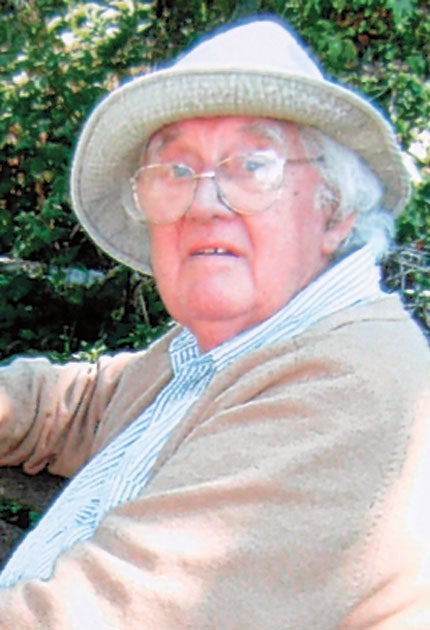Fred Dubery: One of England's leading figurative artists of the 20th century

Fred Dubery was a painter and teacher whose exuberantly coloured canvases found a ready public. From the middle of the last century he developed as one of England's foremost figurative artists.
Dubery was elected to the New English Art Club in 1956, becoming an honorary member 40 years later. He was modest, popular and noted for his sly wit, in appearance rotund, bespectacled and jolly, with a distinctive shock of white hair. Although in 1886 the New English was founded in a spirit of rebellion against the restrictive outlook of the Royal Academy by leading painters such as John Lavery, John Singer Sargent and Philip Wilson Steer, by the time Dubery joined it was established in the London art scene. His landscapes, interiors, still lifes and portraits fitted in well with what the Club stood and continues to stand for.
Frederick Dubery was born in Thornton Heath in 1926, an onlychild but part of the large and close family of Frederic Dubery, a dentalmechanic, and his wife Gladys. Leaving Croydon's Whitgift Grammar School at 16, he worked for an advertising agency before conscription in 1944 into the Royal Artillery, where he was a mapmaker.
Although Fred's widow Joanne does not think he would have been discouraged by his parents in going to art school with an ex-serviceman's grant, she suspects they would have "felt trepidation" that he was entering the world of the "starving, penniless student" and the world of bohemia. After a year at Croydon School of Art (1949-50), Dubery studied from 1950-53 at the Royal College of Art, where Robin Darwin was early in his tenure as a reforming principal.
Like many artists, Dubery had to teach to live. It was at Walthamstow School of Art that in 1960 that he met Joanne Brogden, whom he was to marry five years later in Marseille. She would become Professor of Fashion at the Royal College of Art. Walthamstow in the early 1960s had a great reputation for its visiting staff, which at times included Peter Blake, Fred Cuming, Margaret Green, Derek Hirst, Ken Howard and Jack Smith.
Fred Cuming was a fellow New English Art Club member; he and Dubery were known as "the two Freds" and in the presence of one of them, friends would refer to "the other Fred". Dubery's painting from life The Other Fred's Cat was bought by Sir Christopher Frayling and his wife Helen.
For some artists teaching is a chore. Joanne Dubery says that Fred "loved teaching and helping guide and develop talent in the serious young student. But he only taught two days a week, in order to paint five days a week."
When in 1964 the Royal Academician Peter Greenham was appointed Keeper of the Royal Academy Schools to succeed Sir Henry Rushbury, he invited Dubery to be a visiting tutor. Some 20 years later Dubery became Professor of Perspective, a post he held until the compulsory retirement age of 75. Dubery was passionate about perspective and distilled much of what he knew into two books, written with John Willats: Drawing Systems (1972) and Perspective and other Drawing Systems (1983). Students at the Royal College of Art for some years also benefited from his teaching, where he was a part-time senior lecturer until 1989.
When not teaching, Dubery was as regular and disciplined a painter as the light allowed. "There was nothing bohemian and moody" about his approach to his work, Joanne Dubery says, which was "governed by a hard, quiet intelligence." A clean and scrupulous craftsman, he painted in a French apron with huge pockets full of paint tubes and grubby bits of paper try-outs for colour, on his head a floppy painter's hat.
Dubery has been called "a painter's painter". He was particularly proud of a comment by Jack Smith on one period of his output that it had "the stillness of a Vermeer". However, it was the intimacy of Bonnard and Vuillard that did much to influence his work, especially the quiet domestic interiors of which he was so fond.
Dubery exhibited widely, his mixed shows including the Royal Academy from 1950, the London Group and Hunting Prize Exhibition, and at commercial venues such as the Leicester Galleries, Roland, Browse and Delbanco, and Messums. After solo shows at the Trafford Gallery in 1957 and 1963, others included the New Grafton Gallery from 1974 and Sebastian Pearson Gallery, Cambridge, in 2000. Public galleries in Brighton and Huddersfield, the Nuffield Foundation, the Arts Club, Warburg Institute and Worcester College, Oxford, hold his work.
Frederick Thomas Stanley Dubery, painter and teacher: born Thornton Heath, Surrey 12 May 1926; married 1965 Joanne Brogden; died Bury St Edmunds, Suffolk 8 April 2011.
Join our commenting forum
Join thought-provoking conversations, follow other Independent readers and see their replies
Comments
Bookmark popover
Removed from bookmarks